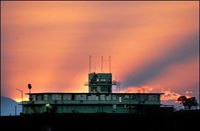No Accountability for Bagram
 The U.S. Army staffed, operated, and condoned the sustained daily functions of a proverbial torture chamber at the Bagram Military Detention Center in Afghanistan in 2002. Now, 2½ years later, the officers responsible for that facility have yet to face the consequences for their leadership failures.
The U.S. Army staffed, operated, and condoned the sustained daily functions of a proverbial torture chamber at the Bagram Military Detention Center in Afghanistan in 2002. Now, 2½ years later, the officers responsible for that facility have yet to face the consequences for their leadership failures.
The dark history of this interrogation and detention facility is mired in denial, gross command irresponsibility at all levels, and soldiers gone wild with rage. Combined, all factors resulted in the injury and in several cases, the death of detainees.
During the course of interrogations, unlucky detainees were routinely abused by the assigned Military Intelligence interrogators from the 519th Military Intelligence Battalion from Fort Bragg, N.C. Augmenting the staff were Military Police soldiers from the Army Reserve's 377th MP Company from Cincinnati, Ohio.
Regarded as potential sources of human intelligence information, detainees being held for interrogation were routinely kicked, beaten, hung by irons from immovable objects to include detention cell ceilings. Their humiliation was constant as a matter of policy. This policy was set by Army Capt. Carolyn A. Wood, an experienced Army interrogator then assigned to the 519th MI Battalion.
Wood posted her own list of “interrogation rules of engagement” (ROE) at Bagram and later did the same when transferred to Abu Ghraib prison west of Baghdad. Wood's ROE were in effect until they were discovered to be inconsistent with interrogation rules published by the CJTF commander in Iraq, Lt. Gen. Ricardo Sanchez.
Given the ghastly treatment that many detainees received at Abu Ghraib, some resulting in horrifying deaths, one may not be shocked with the revelations of abuse at the Bagram facility. Making the situation worse was the likelihood that a detainee in a field detention center may be completely innocent, and guilty of nothing more than being in the wrong place at the wrong time. This did not stop Army MI personnel, and MPs from exacting punishment on detained, injured, and shackled suspects that was no less than horrific.
Such crimes, we now discover, were not rare.
As reported by The New York Times last week, an Afghani named Habibullah was captured by an Afghan Warlord on Nov. 28, 2002. Two days later, he was delivered to the Bagram detention facility by CIA operatives who said that Habibullah was suspected of being a brother of a former Taliban commander from the southern Afghan province of Oruzgan.
Maj. Bobby R. Atwell, a military police officer now assigned to the 16th MP Brigade at Fort Bragg, who was then serving as the provost marshal at Bagram, offered, in an interview with the NY Times, that Habibullah “had a piercing gaze and was very confident.” Perhaps it was this perceived arrogance on the part of the detainee that led to his ultimate fate.
When delivered to the Bagram facility, Habibullah was described as being in good health by the doctor who examined him.
However, the senior intelligence operations chief at Bagram, Lt. Col. John W. Loffert Jr., later told Army investigators, “He was already in bad condition when he arrived.” Since Loffert is not a doctor, the reader must assume one of two things: Either Habibullah had visible symptoms of poor health, or the officer lied.
On his second day in the Bagram facility, interrogators declared Habibullah as being “uncooperative.” According to MP Capt. Christopher M. Beiring, this following a day of being subject to the standard policy of “being hooded, shackled, and isolated for at least the first 24 hours.”
Soldiers who were assigned to the facility readily admitted, in classified investigative reports later released and published in the news media, that the guards kept prisoners awake by yelling or poking at them or banging on their cell doors. This went on while Habibullah was shackled by the wrists to the wire ceiling over his cell door.
To which the question arises: Would you remain calm and cooperative at this juncture after a full day of this kind of welcome at a detention facility?
When it came time for a rectal exam, and more heavy-handed treatment meted out by the guards, it is not surprising that Habibullah became violent. The detainee struck Sgt. Alan J. Driver Jr. – is a reserve MP from the 377th MP Co. – with a knee. That act probably sealed Habibullah's fate.
Later that day, Spec. Willie V. Brand, a guard and not an interrogator with the 377th reported Habibullah as “uncooperative” and then saw fit to deliver a flurry of peroneal strikes in response. This involves kneeing the victim in the muscle group just above the victim’s knee. The next day, Brand found Habibullah uncooperative again, and assaulted the detainee a second time with more knee shots to the legs.
As an MI soldier for more than 30 years, I can attest that nowhere in any Army Training Manual, Army Regulation, or Field Manual does the U.S. Army prescribe numerous and repeated peroneal strikes to the legs or a detainee – for any reason.
It is interesting to note that Brand, ajunior enlisted soldier, has been charged with assault and other crimes perpetrated against detainees. His civilian lawyer, John P. Galligan, is quick to point out that his client, Brand, was performing his duties consistently within the standard operating procedures that were in place at the Bagram facility.
Given the widespread proliferation of catastrophic abuse directed at detainees, and numerous other corroborative facts, Galligan’s assertion has great credibility.
The situation at Bagram continued to spiral out of control. By Dec. 3, 2002, Habibullah’s sustained defiance made him a open target for scores of peroneal strikes for being, again, “noncompliant.”
One M.P., not named in the N.Y. Times, stated that he gave Habibullah five peroneal strikes and another gave him three or four more, again, for being, “combative and noncompliant.” The piece in the N.Y. Times revealed that some guards later asserted that he, Habibullah, had been hurt trying to escape. Some guards later asserted that he had been hurt trying to escape.
How combative can a man be while shackled to the ceiling and chained to the floor by his feet and with a bag over his head? These were the conditions of Habibullah’s detention and restraint on Dec. 3, 2002, according to M.P. Sgt. James P. Boland.
Later that date, Boland found Habibullah, slumped forward and held up by the chains attaching him to the ceiling.
Sgt. Boland informed investigators of Habibullah’s condition. Boland returned and entered the cell with Specialists Anthony M. Morden and Brian E. Cammack, both members of the 377th MP Company. Habibullah’s hood was removed and, according to Cammack, Habibullah then spat on him.
After serving as a municipal police officer during 1972-80, I can attest that this is not an unusual event when dealing with detainees. I and most other police officers have been subjected to much worse.
By his own admission, Cammack stated that, he “exploded” and yelled at Habibullah, “don’t ever spit on me again.” Further, Cammack admitted that he began kneeing the shackled and swaying man in the thigh “maybe a couple” of times. Twenty minutes later, Habibullah was found dead in his cell by Sgt. Boland and Spec. Cammack. According to Boland, “Spec. Cammack appeared very distraught, the soldier was running about the room … hysterically.”
Immediately, another MP was dispatched to find a medic. When his assistance was requested by the MPs, Spec. Robert S. Melone, indignant at being bothered, reportedly said, “What are you getting me for? Call an ambulance instead!” Another medic was contacted, he responded, and found Habibullah on the floor, dead, his arms outstretched, eyes and mouth open wide.
On Dec. 8, 2002, an autopsy performed on Habibullah revealed that his death was attributed to a blood clot that likely traveled to his heart and blocked the blood flow to his lungs. This clot was probably the result of the severe injuries to his legs, according to the autopsy findings. Significantly, the autopsy discovered bruises and abrasions on the victim’s chest, arms and head. Also present were deep contusions on his calves, knees and thighs. His left calf was marked by what appeared to have been the sole of a boot.
The next victim arrived at Bagram on Dec. 5, 2002, only two days after Habibullah’s death. The Afghani, named Dilawar, had been detained on suspicion of firing rockets at a U.S. military site in Afghanistan. He was a taxi driver by profession.
In keeping with Capt. Wood’s rules, both MI and MP escorts would render him a similar fate to that of Habibullah. Prison guards soon declared him “noncompliant,” and his handling and incarceration were almost identical to that of the now deceased detainee
Shackled in his cell, just prior to a scheduled interrogation, Dilawar reportedly spat on MP Spec. Corey E. Jones when the soldier brought him some water. Jones later asserted that as a result he began a series of knee and peroneal strikes to the detainee’s leg.
In response to beating, Dilawar reportedly screamed out, “Allah, Allah, Allah.” Other MP soldiers heard Dilawar screaming, and according to Jones’ own admission, “They thought it was funny.”
Other MPs in the platoon showed up to give Dilawar repeated and sustained peroneal strikes over a 24-hour period. This was done just to hear Dilawar scream, “Allah,” said Jones to CID Investigators. In a subsequent statement to CID, Specialist Jones was vague about which M.P.'s had delivered the blows. His estimate was never confirmed, but other guards eventually admitted striking Mr. Dilawar repeatedly.
On Dec. 8, 2002, the same day as Habibullah’s autopsy, Dilawar was subjected to his fourth interrogation with 21-year-old Spec. Glendale C. Walls II as the interrogator. Walls declared the detainee hostile because he would not admit to allegations that he had launched rockets at the American base.
Dilawar was physically unable to hold his hand-cuffed hands above his head as instructed, which prompted another interrogator, Sgt. Selena Salcido, to forcibly slap Dilawar’s hands back up when they fell. Both interrogators then termed Dilawar evasive because he was unable to sit in a chair due to the injuries he had sustained at the hands of the guards during the past 24 hours. Dilawar was then repeatedly shoved against the wall by Walls and Salcido because he could no longer stand.
According to an interpreter who was present, later identified as Ahmad Ahmadzai, Dilawar received a beating for about ten to fifteen minutes at the hands of Walls and Salcido. The thrashing was highlighted by the violent kicking of Dilawar in the groin, private areas, and one good drop kick, in which Salcido stepped back and advanced rapidly, kicking Dilawar. In published classified investigative reports, Salcido also stepped on Dilawar’s bare foot and pulled him about, physically, by his beard.
Following this sustained attack and beating on Dilawar, which Ahmadzai described as no interrogation at all, Dilawar was returned to his cell and shackled to the ceiling until the next interrogation shift came on. Salcido instructed the MP escorts to shackle Dilawar to the ceiling in his cell.
The next morning, Dec. 9, 2002, Dilawar was subjected to his final interrogation at which he was unable to kneel when ordered or physically comply with anything. This caused the interrogation session to erode to more physical abuse. An interrogator identified as Spec. Joshua Claus took over from Walls, who remained present. Dilawar’s last interrogation eroded into more abuse and assault and he was returned to his cell and re-shackled.
Dilawar was found dead the next morning.
Claus and Walls have both since been charged with assault, prisoner maltreatment, and lying to investigators.
Shortly after Dilawar’s death Lt. Col. Elizabeth Rouse, the corner, who was a Major at the time, determined that Dilawar suffered injuries so extreme that one of his legs “had basically been pulpified.” Rouse further commented regarding Dilawar’s fate and demise, “I’ve seen similar injuries in an individual run over by a bus.”
In February 2003, while making an effort deny the criminal actions of soldiers and leaders alike, Lt. Gen. Daniel K. McNeill, commander of allied forces in Afghanistan, released a statement that said, in part: “We are not chaining people to the ceilings .… I will say that our interrogation techniques are adapted, they are in accordance with what is generally accepted as interrogation techniques.”
As with the infamous guards at Abu Ghraib, one must ask, where was the supervision by the guards’ chain of command? Who was in charge? Where were the officers and commanders during that month when two detainees were viciously beaten to death in a gruesome, painful and bizarre manner? Where was any level of senior noncommissioned officer leadership? Just who in hell was in operational charge of these specialists and junior NCOs? Who was setting policy and monitoring those policies?
The answer is that Capt. Carolyn A. Wood, a vastly experienced U.S. Army intelligence officer. Wood, recall, was the officer in charge of interrogations and intelligence collection operations at Bagram in December 2002. Wood is currently assigned to duties as the adjutant of the 304th MI Battalion at Fort Huachuca, Ariz.
A former enlisted soldier and former staff sergeant in the MI career field, Wood later became a commissioned officer. At Bagram, she wrote and posted her own “rules of interrogation” for detainees. In mid-2003, Wood was reassigned to Abu Ghraib prison with essentially the same duties. While there, she fell under the ineffective leadership of Lt. Col. Steven P. Jordan, of the 205th MI Brigade, which was responsible for detainee interrogations at the prison.
Also, according to the N.Y. Times, in a piece written by Douglas Jehl and Eric Schmitt, which appeared on May 21, 2004, upon arriving at Abu Ghraib, Wood again posted her “interrogation rules and operational directives.” Effectively, she had imported and applied many of the harsh methods that seemed to work for her unit at the Afghanistan site.
The aftermath of the detainees’ deaths at Bagram is sickeningly similar to that of the Abu Ghraib scandal: To date, only seven junior enlisted soldiers have been accused and or/punished for their involvement as part of Wood’s team in Afghanistan, although according published news reports, over 28 soldiers have been implicated in the two murders thus far.
Spec. Cammack last week pleaded guilty at a court-martial at Fort Bliss, Tex., to assault and two counts of making a false statement relating to his assault on Habibullah. The military judge sentenced Cammack to three months in prison, reduced him to the rank of private, issued a fine, and gave him a bad-conduct discharge.
As of this writing, the Army has made no move to prefer criminal charges against Capt. Wood, who – to no one’s surprise – was unavailable for comment.
The illegal beating of detainees may be over, but the Army’s accountability scandal continues.
Subscribe to Pravda.Ru Telegram channel, Facebook, RSS!





